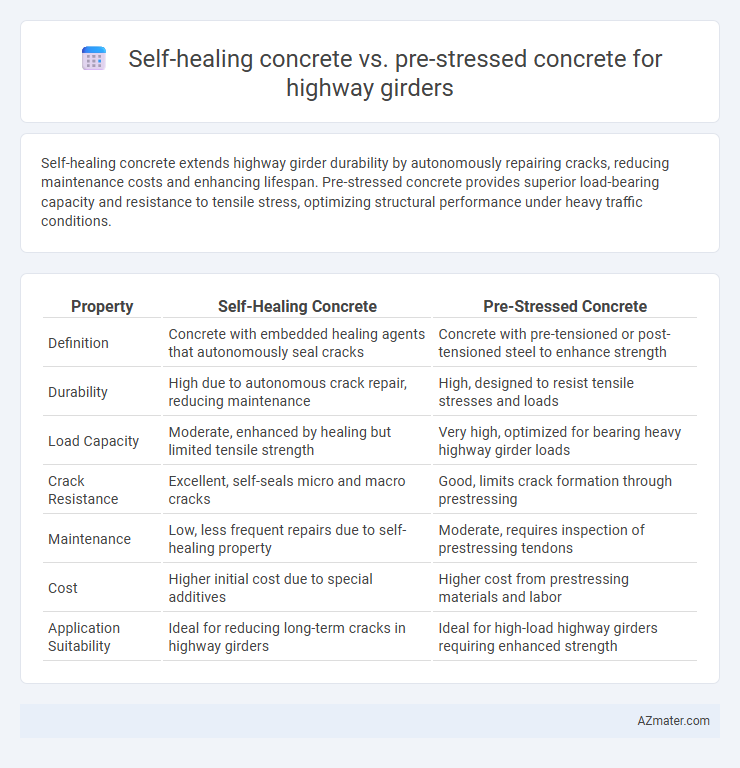Self-healing concrete extends highway girder durability by autonomously repairing cracks, reducing maintenance costs and enhancing lifespan. Pre-stressed concrete provides superior load-bearing capacity and resistance to tensile stress, optimizing structural performance under heavy traffic conditions.
Table of Comparison
| Property | Self-Healing Concrete | Pre-Stressed Concrete |
|---|---|---|
| Definition | Concrete with embedded healing agents that autonomously seal cracks | Concrete with pre-tensioned or post-tensioned steel to enhance strength |
| Durability | High due to autonomous crack repair, reducing maintenance | High, designed to resist tensile stresses and loads |
| Load Capacity | Moderate, enhanced by healing but limited tensile strength | Very high, optimized for bearing heavy highway girder loads |
| Crack Resistance | Excellent, self-seals micro and macro cracks | Good, limits crack formation through prestressing |
| Maintenance | Low, less frequent repairs due to self-healing property | Moderate, requires inspection of prestressing tendons |
| Cost | Higher initial cost due to special additives | Higher cost from prestressing materials and labor |
| Application Suitability | Ideal for reducing long-term cracks in highway girders | Ideal for high-load highway girders requiring enhanced strength |
Introduction to Highway Girder Technologies
Highway girder technologies have evolved to enhance durability and load-bearing capacity, with self-healing concrete offering innovative crack repair through embedded microcapsules or bacteria, reducing maintenance costs and extending service life. Pre-stressed concrete girders employ tensioned steel tendons to counteract tensile stresses, enabling longer spans and improved structural efficiency under heavy highway traffic loads. The integration of self-healing materials in pre-stressed concrete aims to combine advanced durability with high structural performance for modern highway infrastructure.
Overview of Self-Healing Concrete
Self-healing concrete incorporates microcapsules or bacteria that activate upon cracking, promoting automatic repair and extending the lifespan of highway girders by reducing maintenance costs. This technology enhances durability by sealing microcracks and preventing corrosion in prestressed reinforcement, which is crucial for infrastructure longevity. While pre-stressed concrete relies on tensioned steel to improve load-bearing capacity, self-healing concrete fundamentally improves material resilience through autonomous crack closure.
Overview of Pre-Stressed Concrete
Pre-stressed concrete is a high-strength composite material extensively used in highway girders to enhance load-bearing capacity and control tensile stresses. By tensioning steel tendons before concrete curing, it significantly reduces cracking and deflection under heavy traffic loads. This method improves durability and extends the lifespan of infrastructure compared to traditional concrete solutions.
Material Composition and Mechanisms
Self-healing concrete incorporates microcapsules containing healing agents such as epoxy or bacteria-activated compounds within a traditional cement matrix, enabling autonomous crack repair through chemical reactions or microbial activity. Pre-stressed concrete comprises high-tensile steel strands or cables embedded under tension within the concrete, which is primarily composed of Portland cement, aggregates, and admixtures, to counteract tensile stresses and improve load-bearing capacity. The key mechanism in self-healing concrete is the autonomous sealing of microcracks through material release or biological deposition, whereas pre-stressed concrete relies on induced compressive forces from tensioned steel to enhance structural performance and durability.
Construction Processes Compared
Self-healing concrete for highway girders involves integrating microcapsules or bacteria-based agents into the mix, enabling autonomous crack repair during service life, which minimizes maintenance frequency and extends durability. Pre-stressed concrete requires tensioning steel tendons before or after casting, necessitating precise anchoring and stressing equipment, leading to more complex and labor-intensive construction procedures. The self-healing concrete process reduces reliance on specialized post-tensioning machinery, offering potential time savings and lower lifecycle costs compared to the highly controlled pre-stressed concrete construction workflow.
Durability and Longevity
Self-healing concrete enhances highway girder durability by autonomously repairing microcracks, reducing water ingress and corrosion risks, which extends service life significantly. Pre-stressed concrete offers high initial strength and crack control through induced compressive stresses, improving long-term structural performance under heavy loads. While pre-stressed concrete provides immediate load-bearing advantages, self-healing concrete advances longevity by mitigating maintenance needs and preventing deterioration over time.
Maintenance and Repair Needs
Self-healing concrete significantly reduces maintenance and repair needs for highway girders by autonomously sealing micro-cracks through biological or chemical processes, enhancing durability and extending service life. In contrast, pre-stressed concrete requires periodic inspections and external interventions to address stress-related cracks and potential corrosion of tendons, leading to higher long-term maintenance costs. The integration of self-healing properties offers a cost-effective and sustainable solution for minimizing downtime and repair expenditures in highway infrastructure.
Cost Analysis and Economic Impact
Self-healing concrete reduces long-term maintenance costs for highway girders by autonomously repairing cracks, potentially lowering lifecycle expenses compared to traditional pre-stressed concrete, which demands periodic external maintenance and repair. Pre-stressed concrete offers immediate structural benefits through enhanced load-bearing capacity and reduced material thickness, decreasing initial construction costs but may incur higher cumulative maintenance costs over time. Economic impact analysis reveals that while pre-stressed concrete ensures upfront budget predictability, self-healing concrete's innovation drives future savings by extending service life and minimizing repair interventions on highway infrastructure.
Sustainability and Environmental Benefits
Self-healing concrete significantly reduces maintenance frequency and extends the lifespan of highway girders by autonomously repairing micro-cracks, thereby minimizing resource consumption and waste generation. In contrast, pre-stressed concrete provides enhanced load capacity and durability but does not address crack-induced degradation, often requiring more frequent repairs with associated environmental impacts. Utilizing self-healing concrete promotes sustainability through decreased carbon emissions and lower demand for raw materials over the girder's lifecycle, aligning with green infrastructure goals.
Future Trends in Highway Girder Innovation
Self-healing concrete offers promising future trends in highway girder innovation by autonomously repairing micro-cracks, thereby extending the lifespan and reducing maintenance costs. Pre-stressed concrete continues to enhance load-bearing capacity and resistance to tensile stress, but integrating self-healing capabilities with pre-stressed technology is emerging as a cutting-edge approach. Advancements in material science and nanotechnology are driving the development of smart, durable girders that combine the strengths of both methods to improve infrastructure resilience and sustainability.

Infographic: Self-healing concrete vs Pre-stressed concrete for Highway girder
 azmater.com
azmater.com